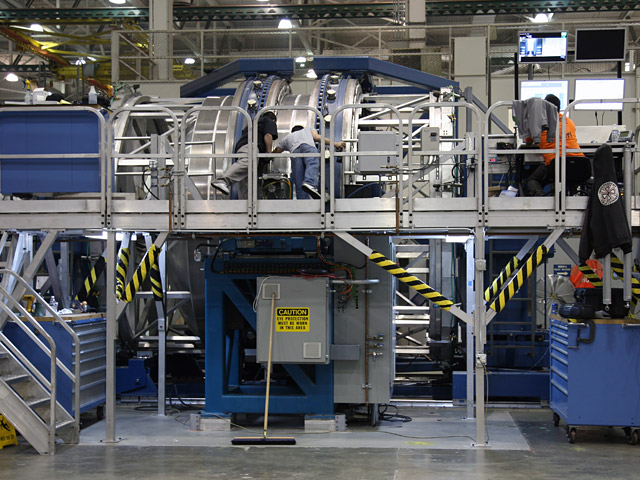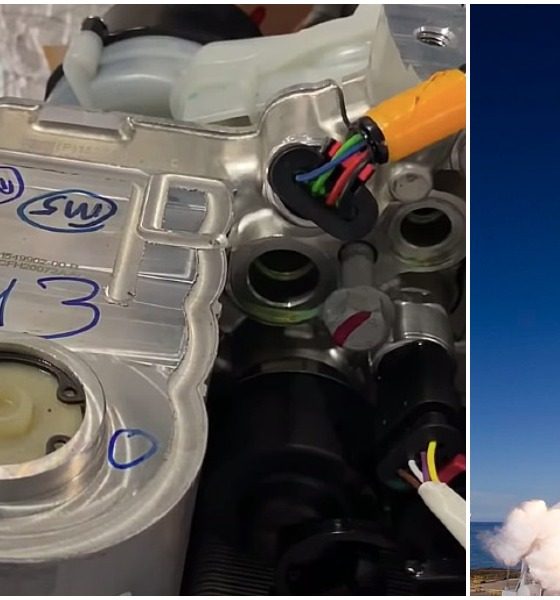A recent episode of Sandy Munro’s Tesla Model Y teardown series has revealed that the electric car company utilized friction stir welding (FSW) for the crossover’s thermal management system. The welding technique is commonly used among aerospace companies, like SpaceX, as a way to maintain the strength of aluminum parts while securing a reliable bond between pieces.
Munro’s analysis of the Octovalve coolant system revealed Tesla’s techniques for the revised thermal management portion of the Model Y. Munro discovered the Octovalve on April 4 after digging into the Model Y’s internal build. The new coolant assembly seemed to be a revised version of the Model 3’s “Superbottle,” which served as the heart of the sedan’s thermal management system.
A car’s thermal management apparatus is responsible for controlling and maintaining proper temperatures in critical portions of the vehicle. In the case of the Model Y, the Octovalve is responsible for motor, battery, and cabin cooling, according to Munro. The Detroit auto veteran said that typically, these systems should not be cooling the cabin if they are controlling battery or motor temperature. The thermal management system in the Model Y seems to be controlling the cabin, the battery, the electronics, and the motor nonetheless.

The Octovalve seems to be a state-of-the-art system as it uses, “some clever little ball valves that open and close to make sure that everything’s getting heated or everything’s being cooled to where it needs to be,” Munro said.
With the assembly overlooking the temperature for these many parts of the vehicle, the system is subjected to drastic and sharp temperature changes. Over time, the difference between heat and cold can begin to weaken portions of the car part, especially if it was exposed to excessive temperatures during manufacturing. This is where some SpaceX-grade solutions come into play.
Tesla chose to utilize friction stir welding for its aluminum portions of the coolant assembly. “This is a cool way of putting two parts of aluminum together, some other materials as well, but aluminum is kind of the most suited for it. And in essence, what happens is you have a stylus that spins around very very quickly. It pokes through the two pieces of metal that you want to friction stir weld. Then, it goes around the outside edge, and what it does is it uses the plastic state or thixotropic state of the aluminum to bind it together,” Munro said.
Simply put, the process allows aluminum to reach a temperature that allows two pieces of metal to come together with a strong bond, but it never turns the metal into a soft, liquid-like state. “It’s like soft butter, butter that you could see is firm, but you could cut it with a knife.”
The advantage of using this process is that the heat from the welding process only applies to the outer edges of the metal. The additional material that is not bonded to anything does not see the heat and is not weakened by the welding process. Stir welding is also time effective as it can be completed in a short period, but it is a careful process that does not apply unneeded stress upon the rest of the assembly.

SpaceX uses friction stir welding for its rockets, as it increases strength by exposing only the bonded portions of two pieces of metal to each other. Friction stir welding was used by SpaceX back in 2008 when the company was combining barrel sections of the Falcon 9’s second stage. “The FSW joins metal without flames, sparking, inert gasses, or fumes, and produces a far superior weld in aluminum-lithium alloys as compared to traditional methods,” SpaceX said in a news update.
In the spirit of humor, Tesla and Elon Musk saw the Octovalve as a perfect opportunity to not only improve the performance of the vehicle temperature regulation system but also as an appropriate time to sprinkle in some additional humor in the form of an Easter Egg. The Model 3 donned a cape-wearing bottle-figured superhero for its “Superbottle” system, while the Model Y includes a snowflake-stamped Octopus as an Easter Egg.
Tesla has increased the effectiveness of its thermal management with the introduction of the Model Y’s Octovalve system. Elon Musk stated that it was some of the best engineering he had ever seen. The welding process could increase the longevity of the machine through its lack of exposure to excessive heat and stress during manufacturing.
Watch Munro’s video on the Model Y’s Octovalve welding below.

Elon Musk
Elon Musk and Tesla AI Director share insights after empty driver seat Robotaxi rides
The executives’ unoccupied tests hint at the rapid progress of Tesla’s unsupervised Robotaxi efforts.

Tesla CEO Elon Musk and AI Director Ashok Elluswamy celebrated Christmas Eve by sharing personal experiences with Robotaxi vehicles that had no safety monitor or occupant in the driver’s seat. Musk described the system’s “perfect driving” around Austin, while Elluswamy posted video from the back seat, calling it “an amazing experience.”
The executives’ unoccupied tests hint at the rapid progress of Tesla’s unsupervised Robotaxi efforts.
Elon and Ashok’s firsthand Robotaxi insights
Prior to Musk and the Tesla AI Director’s posts, sightings of unmanned Teslas navigating public roads were widely shared on social media. One such vehicle was spotted in Austin, Texas, which Elon Musk acknowleged by stating that “Testing is underway with no occupants in the car.”
Based on his Christmas Eve post, Musk seemed to have tested an unmanned Tesla himself. “A Tesla with no safety monitor in the car and me sitting in the passenger seat took me all around Austin on Sunday with perfect driving,” Musk wrote in his post.
Elluswamy responded with a 2-minute video showing himself in the rear of an unmanned Tesla. The video featured the vehicle’s empty front seats, as well as its smooth handling through real-world traffic. He captioned his video with the words, “It’s an amazing experience!”
Towards Unsupervised operations
During an xAI Hackathon earlier this month, Elon Musk mentioned that Tesla owed be removing Safety Monitors from its Robotaxis in Austin in just three weeks. “Unsupervised is pretty much solved at this point. So there will be Tesla Robotaxis operating in Austin with no one in them. Not even anyone in the passenger seat in about three weeks,” he said. Musk echoed similar estimates at the 2025 Annual Shareholder Meeting and the Q3 2025 earnings call.
Considering the insights that were posted Musk and Elluswamy, it does appear that Tesla is working hard towards operating its Robotaxis with no safety monitors. This is quite impressive considering that the service was launched just earlier this year.
Elon Musk
Starlink passes 9 million active customers just weeks after hitting 8 million
The milestone highlights the accelerating growth of Starlink, which has now been adding over 20,000 new users per day.

SpaceX’s Starlink satellite internet service has continued its rapid global expansion, surpassing 9 million active customers just weeks after crossing the 8 million mark.
The milestone highlights the accelerating growth of Starlink, which has now been adding over 20,000 new users per day.
9 million customers
In a post on X, SpaceX stated that Starlink now serves over 9 million active users across 155 countries, territories, and markets. The company reached 8 million customers in early November, meaning it added roughly 1 million subscribers in under seven weeks, or about 21,275 new users on average per day.
“Starlink is connecting more than 9M active customers with high-speed internet across 155 countries, territories, and many other markets,” Starlink wrote in a post on its official X account. SpaceX President Gwynne Shotwell also celebrated the milestone on X. “A huge thank you to all of our customers and congrats to the Starlink team for such an incredible product,” she wrote.
That growth rate reflects both rising demand for broadband in underserved regions and Starlink’s expanding satellite constellation, which now includes more than 9,000 low-Earth-orbit satellites designed to deliver high-speed, low-latency internet worldwide.
Starlink’s momentum
Starlink’s momentum has been building up. SpaceX reported 4.6 million Starlink customers in December 2024, followed by 7 million by August 2025, and 8 million customers in November. Independent data also suggests Starlink usage is rising sharply, with Cloudflare reporting that global web traffic from Starlink users more than doubled in 2025, as noted in an Insider report.
Starlink’s momentum is increasingly tied to SpaceX’s broader financial outlook. Elon Musk has said the satellite network is “by far” the company’s largest revenue driver, and reports suggest SpaceX may be positioning itself for an initial public offering as soon as next year, with valuations estimated as high as $1.5 trillion. Musk has also suggested in the past that Starlink could have its own IPO in the future.
News
NVIDIA Director of Robotics: Tesla FSD v14 is the first AI to pass the “Physical Turing Test”
After testing FSD v14, Fan stated that his experience with FSD felt magical at first, but it soon started to feel like a routine.

NVIDIA Director of Robotics Jim Fan has praised Tesla’s Full Self-Driving (Supervised) v14 as the first AI to pass what he described as a “Physical Turing Test.”
After testing FSD v14, Fan stated that his experience with FSD felt magical at first, but it soon started to feel like a routine. And just like smartphones today, removing it now would “actively hurt.”
Jim Fan’s hands-on FSD v14 impressions
Fan, a leading researcher in embodied AI who is currently solving Physical AI at NVIDIA and spearheading the company’s Project GR00T initiative, noted that he actually was late to the Tesla game. He was, however, one of the first to try out FSD v14.
“I was very late to own a Tesla but among the earliest to try out FSD v14. It’s perhaps the first time I experience an AI that passes the Physical Turing Test: after a long day at work, you press a button, lay back, and couldn’t tell if a neural net or a human drove you home,” Fan wrote in a post on X.
Fan added: “Despite knowing exactly how robot learning works, I still find it magical watching the steering wheel turn by itself. First it feels surreal, next it becomes routine. Then, like the smartphone, taking it away actively hurts. This is how humanity gets rewired and glued to god-like technologies.”
The Physical Turing Test
The original Turing Test was conceived by Alan Turing in 1950, and it was aimed at determining if a machine could exhibit behavior that is equivalent to or indistinguishable from a human. By focusing on text-based conversations, the original Turing Test set a high bar for natural language processing and machine learning.
This test has been passed by today’s large language models. However, the capability to converse in a humanlike manner is a completely different challenge from performing real-world problem-solving or physical interactions. Thus, Fan introduced the Physical Turing Test, which challenges AI systems to demonstrate intelligence through physical actions.
Based on Fan’s comments, Tesla has demonstrated these intelligent physical actions with FSD v14. Elon Musk agreed with the NVIDIA executive, stating in a post on X that with FSD v14, “you can sense the sentience maturing.” Musk also praised Tesla AI, calling it the best “real-world AI” today.










